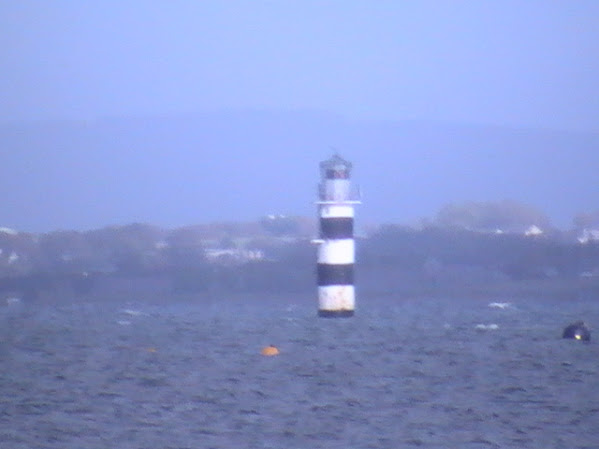The Leverets, Galway Bay
The much overlooked Leverets lighthouse on the approach to the docks in Galway (photograph Marinas.com)
I suppose its only natural that lighthouses that never had a keeper should fall under the radar somewhat. Ardnakinna, Rosslare Copper Point and the Leverets don't really have that folk memory that allows them to gain kudos in the lighthouse world, which is a shame because Leverets, for one, is quite an interesting structure.
For a start, the name is somewhat strange. People who do pub quizzes (do they still exist in the era of the mobile phone?) will know that a leveret is a young hare, with no obvious connection to lighthouse. But the Leverets are two rocks that the lighthouse is built on and the nearby slightly larger land masses are called Hare Island and Rabbit Island.
For a start, the name is somewhat strange. People who do pub quizzes (do they still exist in the era of the mobile phone?) will know that a leveret is a young hare, with no obvious connection to lighthouse. But the Leverets are two rocks that the lighthouse is built on and the nearby slightly larger land masses are called Hare Island and Rabbit Island.
With the development of Galway and particularly the city shoreline in the 1950s and 1960s, the light on Mutton Island, which previously had marked the entrance to the docks (as well as warning away from nearby rocks) was often swamped by the bright city lights, much like Ferris Point at Larne being subsumed by the nearby power station. It was felt that Mutton Lighthouse's days were numbered and a new light, out in the bay was needed.
Photo from the worldoflighthouses.net
Work on the new light began in 1969 and the light was established at the end of September that year. Not only did it mark the Leveret rocks but it also indicated where the final turn should come on the entry to the docks. It was actually constructed in Galway docks and towed out to the location (a la Kish!!) where divers had prepared the base. It was then anchored firmly to the base.
City Tribune 19th June 1985
Trabas Online List of Lights
There was, however, one rather distressing consequence of the building of the lighthouse. For four years prior to the lighthouse's construction, Galway had its very own Fungie, who used to entertain the population with its acrobatic tricks. Flipper - as it was unimaginatively named - was a one-ton, 12-foot long, silver-grey porpoise whose playful antics included befriending the UK's Ambassador to Ireland, who liked fishing in Galway Bay, knocking cement bags off pontoons and fouling ropes.
Unfortunately, due to his habit of habitually nudging the divers working on the base of the new lighthouse and with the possibility of him fouling their airlines, it was decided Flipper would have to be culled. A horrified UK Ambassador pleaded for mercy and it was decided to simply frighten him away with small explosives (the dolphin, not the ambassador) However, a couple of days after this resolution was agreed upon, the headless body of Flipper was found attached to a rope and floating thirty yards to the west of the lighthouse. The construction company denied all knowledge.
Sensitive headline from the Trib (Irish Newspaper Archive)
"When the sun goes down on Galway Bay in the near future, it will be replaced by a bright new light - and it won't be the moon rising over Claddagh." So began the Connacht Sentinel article in September 1969, a few days prior to the establishment of the light. It went on to explain that the lighthouse would be fitted with special light-sensitive plates and, as soon as the light from the sun dropped below a certain intensity, the light would automatically spring into action. Fog would likewise trigger the light. It was not however mentioned how the civil authorities had managed to stop the moon rising over Claddagh.
It was, added the Irish Independent, the first lighthouse in Irish waters to incorporate this system.

From This is Galway
Despite the suggestion that the Leverets was replacing the Mutton Island light, the two co-existed serenely for eight years before the latter was turned off in 1977. It was in fact replaced by a new system of beacons and buoys that were more visible from seaward.
In 1985, the Leverets went solar after a lot of costly niggles with the acetylene. The light kept going out in the middle of the night and a new cannister had to be filled up in Dublin and transported down. Both the Leverets and the shoreline Renmore light were converted to solar panels at a cost of £7,000 with each battery pack having a shelf life of between five and ten years.










Comments
Post a Comment